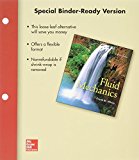
Concept explainers
(a)
Whether the flow is steady or unsteady.
Whether the flow is two or three dimensional.
The acceleration
Answer to Problem 4.1P
The given flow is an unsteady flow.
The flow is a three dimensional flow.
The acceleration vector of the velocity field is
Explanation of Solution
Given information:
Write the expression for the idealized velocity field.
Here, the variables for position are
The given point on the velocity field is
A unsteady flow is a flow that changes with respect to time.
The given velocity field has a component of time. Hence, the flow is an unsteady flow.
A two dimensional flow is a flow that has two components of velocity and a three dimensional flow has three components of velocity.
As the given flow field has three components of velocity hence, it is a three dimensional flow.
Write the general expression for the velocity field.
Here, the velocity function in x-coordinate is
Write the expression for the acceleration function along x-coordinate with respect to time.
Here, the velocity gradient of
Write the expression for the acceleration function in y-coordinate with respect to time.
Here, the velocity gradient of
Write the expression for the acceleration function in z-coordinate with respect to time.
Here, the velocity gradient of
Write the expression for acceleration.
Substitute
Substitute
Substitute
Substitute
Calculation:
Substitute
Conclusion:
Thus, the given flow is an unsteady flow.
Thus, the given flow is three-dimensional.
Thus, the acceleration vector of the velocity field is
(b)
The unit vector normal to the acceleration.
Answer to Problem 4.1P
The unit vector normal to the acceleration is
Explanation of Solution
Write the general expression for the acceleration.
Here, the component of acceleration in x-coordinate is
Write the expression for unit vector normal to acceleration.
Calculation:
Substitute
Conclusion:
Thus, the unit vector normal to the acceleration is
Want to see more full solutions like this?
Chapter 4 Solutions
Package: Loose Leaf For Fluid Mechanics With 1 Semester Connect Access Card
 Elements Of ElectromagneticsMechanical EngineeringISBN:9780190698614Author:Sadiku, Matthew N. O.Publisher:Oxford University Press
Elements Of ElectromagneticsMechanical EngineeringISBN:9780190698614Author:Sadiku, Matthew N. O.Publisher:Oxford University Press Mechanics of Materials (10th Edition)Mechanical EngineeringISBN:9780134319650Author:Russell C. HibbelerPublisher:PEARSON
Mechanics of Materials (10th Edition)Mechanical EngineeringISBN:9780134319650Author:Russell C. HibbelerPublisher:PEARSON Thermodynamics: An Engineering ApproachMechanical EngineeringISBN:9781259822674Author:Yunus A. Cengel Dr., Michael A. BolesPublisher:McGraw-Hill Education
Thermodynamics: An Engineering ApproachMechanical EngineeringISBN:9781259822674Author:Yunus A. Cengel Dr., Michael A. BolesPublisher:McGraw-Hill Education Control Systems EngineeringMechanical EngineeringISBN:9781118170519Author:Norman S. NisePublisher:WILEY
Control Systems EngineeringMechanical EngineeringISBN:9781118170519Author:Norman S. NisePublisher:WILEY Mechanics of Materials (MindTap Course List)Mechanical EngineeringISBN:9781337093347Author:Barry J. Goodno, James M. GerePublisher:Cengage Learning
Mechanics of Materials (MindTap Course List)Mechanical EngineeringISBN:9781337093347Author:Barry J. Goodno, James M. GerePublisher:Cengage Learning Engineering Mechanics: StaticsMechanical EngineeringISBN:9781118807330Author:James L. Meriam, L. G. Kraige, J. N. BoltonPublisher:WILEY
Engineering Mechanics: StaticsMechanical EngineeringISBN:9781118807330Author:James L. Meriam, L. G. Kraige, J. N. BoltonPublisher:WILEY





